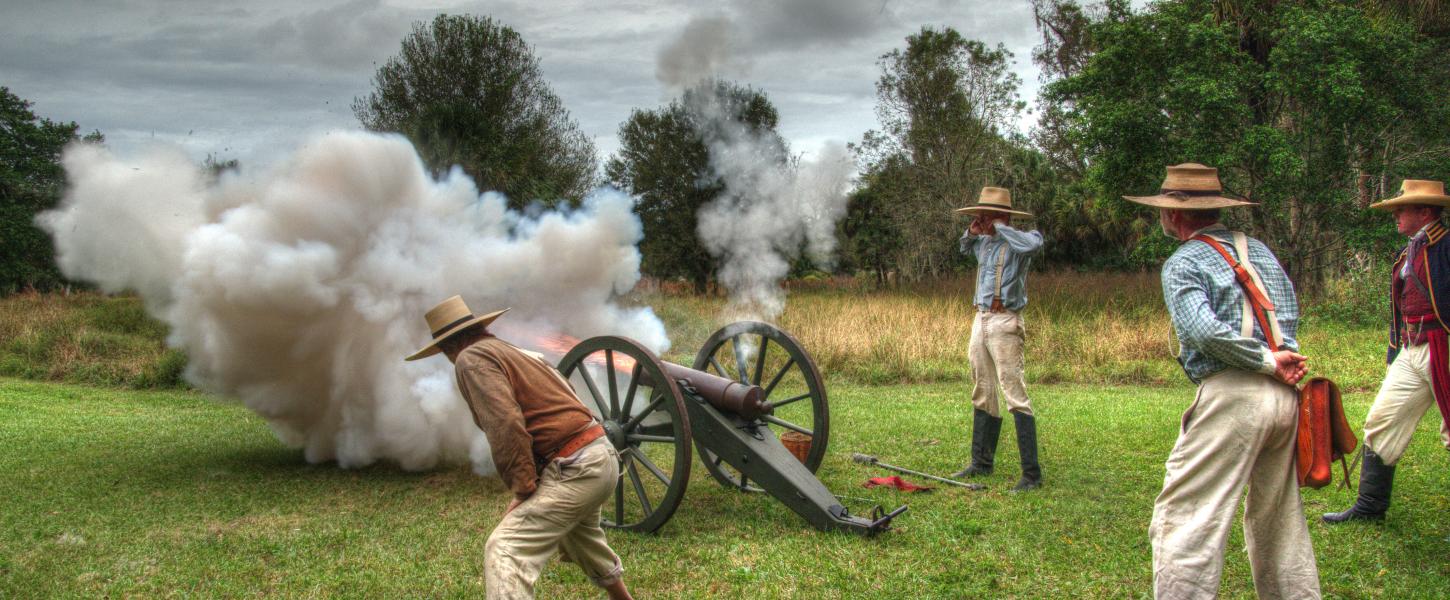Battle of Okeechobee

Okeechobee Battlefield was acquired on November 30, 2006 with funds from the Florida Forever Program. The original Battle of Okeechobee Marker which stands in the park was erected in 1939 by Descendants of Colonel Richard Gentry, and the Florida Society of Daughters of the American Revolution.
Okeechobee Battlefield Historic State Park is located on a portion of the Okeechobee Battlefield, the site of the largest and bloodiest battle of the Second Seminole War (1835 - 1842). The Second Seminole War, the second in a series of three wars fought between white settlers and Native American tribes, was the longest and costliest of the wars in terms of both monetary expense and human casualties. The Battle of Okeechobee occurred on Christmas Day, 1837, when approximately 800 troops of the Infantry Regiments, under the command of Colonel Zachary Taylor, attacked between 380 and 480 Seminole and Miccosukee Native Americans who were camped on the northeast shore of Lake Okeechobee.
Prior to this, Taylor was leading his troops down the Kissimmee River when they received word of the encampment. Taylor ordered a frontal assault, as opposed to surrounding the hammock of dense trees and attacking. But, little did they know that the Seminoles had sensed their arrival and had prepared for such an attack. In preparation, the Seminoles had cut the grass short on the top of a hammock that overlooked the swampy area where they hid. This allowed for an unobstructed and open firing lane. They also took advantage of the fact that the much in this area was so thick that soldiers and horses alike would sink into it and be slowed as they trudged through it. Scouts also kept a look out for the approaching enemy, ready to alert their army at a moment’s notice.
The initial Seminole fire sent Taylor’s troops fleeing. Taylor was persistent through, sending in rank after rank of troops to attack. With Taylor’s final infantry being sent in, they were able to overtake the Seminoles and Miccosukee and drive them away from the battlefield. After claiming the area, Taylor called in his reserve First Infantry to secure the area, thereby claiming victory. Of the soldier's casualties, 28 were killed and 112 wounded, and many of the wounded would die of injuries soon after.
The American press hailed it as a great victory and Zachary Taylor became a national hero, was made a general, and took his first steps toward the presidency. Taylor was able to drive the Seminole and Miccosukee from the field of battle and he did round up 100 horses and 600 head of cattle the warriors left behind when they fled. Despite these spoils, modern historians question how great of a victory it really was. Taylor’s men had killed few of their enemy. In contrast, approximately one third of the soldiers who had attacked the hammock before the reserves were sent in were dead or wounded. With half of Taylor's force out of action, including the majority of Taylor's officers and non-commissioned officers killed, the Seminole and Miccosukee had gained time to make their escape to the safety of the Everglades. It’s unknown if the warriors dragged bodies off when they escaped but there were only 12 Seminole bodies found in the hammock. From interviews and stories many years later, some of the native participants of the battle would state that another 11 warriors were wounded. The Seminoles and Miccosukee drove their families and meager belongings deeper into the Everglades where an estimated 300 of the original 3,000 would hide on remote islands for the next decade or longer.
In 2000, the National Trust for Historic Preservation added the site of the Battle of Okeechobee to the list of “American’s Most Endangered Historic Places.” Each year a battle reenactment is held for the benefit of the state park and in remembrance of the events that took place on this land.